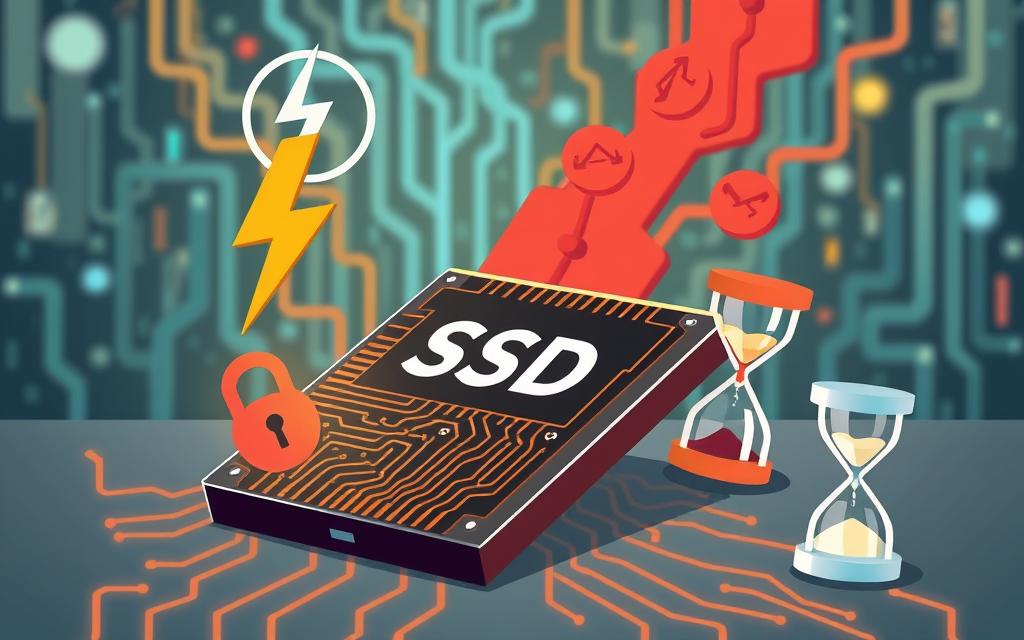In today’s world, getting back files from SSDs is more important than ever. SSDs are fast, durable, and save energy. They are chosen by many for storing data. But it’s key to know how they work and what risks they face. This will help in recovering data if lost.
SSDs might be great, but they can lose data. This might happen due to power failures or when the file system gets corrupt. This guide will teach you how to enhance your chances of getting your data back.
Introduction to SSDs
In the digital age, knowing about data storage is key. Solid-state drives (SSDs) are a big leap forward. They change how we store and get to our data, far outdoing older tech.
What is an SSD?
An SSD, or solid-state drive, keeps data using semiconductor flash memory. This is different from the magnetic bits in hard disks. Thanks to SSD technology, you get to data faster, your device works better, and it lasts longer. With no moving parts, SSDs are quiet and tough.
Unlike hard disks, SSDs don’t slow down because they have no moving parts. They are way faster, which is why they are the top choice for laptops and servers.
| Feature | SSD | HDD |
|---|---|---|
| Speed | Fast read/write speeds | Slower due to mechanical parts |
| Durability | Resistant to shocks and vibrations | Susceptible to physical damage |
| Power Consumption | Lower | Higher |
| Noise Level | Silent operation | Noisy due to moving parts |
The use of SSDs is growing in homes and businesses. This mirrors our need for data storage that’s both reliable and efficient.
Why SSDs are Popular
People are choosing solid-state drives (SSDs) more often because they last longer and are more reliable. Unlike hard disk drives (HDDs), SSDs have no moving parts. This means they are less likely to break. Because they don’t move, SSDs can handle bumps and drops much better. This makes them great for devices you take on the go.
Durability and Reliability
SSDs also have a longer life. They work well at cooler temperatures, which helps them last longer. They’re less likely to lose data from hardware problems. This makes SSDs a reliable choice for keeping your data safe.
Performance Advantages
The speed of SSDs also adds to their appeal. They can work up to 100 times quicker than HDDs. This means your computer starts up faster and files move quicker. There’s hardly any wait to get to your data, which is great for games or editing videos. This speed and reliability make SSDs the top choice for experts and companies who need to manage their data well.
| Feature | SSD | HDD |
|---|---|---|
| Speed | Up to 100 times faster | 5400-7200 RPM |
| Durability | No moving parts | Mechanical parts susceptible to failure |
| Heat Generation | Lower | Higher |
| Lifespan | Longer due to less wear | Shorter, dependent on mechanical wear |
| Data Access | Near-instantaneous | Mechanical delays present |
Understanding Data Loss on SSDs
It’s vital to know how data loss happens on SSDs if you use them. Although SSDs are great, they can still lose data. Some reasons for this include accidental deletion and hardware problems. Spotting when an SSD might fail helps keep your files safe.
Common Causes of Data Loss
Being aware of what causes SSD data loss is useful. Here are the main reasons:
- Accidental deletion: Sometimes, important files get deleted by mistake.
- File system corruption: When the file system messes up, you can’t get to your data.
- Hardware failure: If SSDs get physically damaged, they might not work well.
- Software problems: Bad software or malware can mess up your data too.
Signs of SSD Failure
Noticing early signs of SSD issues is key to keeping your data. Watch out for things like:
- Slow performance: If your SSD slows down, it might be failing.
- Frequent system crashes: If your computer often crashes, the SSD could be the problem.
- Inaccessible files: Trouble with opening or finding files is a warning sign.
Knowing what leads to SSD data loss and spotting failure signs helps. You can protect your data by doing regular backups and keeping an eye on how your SSD performs. This reduces the risk of losing your data for good.

Recovering Files from SSD
Recovering files from an SSD has its unique challenges because of how flash memory works. SSD recovery techniques vary based on how much damage there is. It’s crucial to understand these methods if you want to recover SSD files.
Data Recovery Techniques
There are two main methods for SSD data recovery: logical and chip-off recovery. Logical recovery fixes the file system through software to get back lost data. It’s good for common recovery tasks.
Chip-off recovery is for when there’s lots of damage. It means taking data straight from the memory chips, needing special tools and skills. Each method suits different data loss situations, demanding knowledge of SSD structure.
Using Software for Recovery
Choosing the right SSD data recovery software is crucial. Tools like Disk Drill and DiskGenius stand out for their ease of use and effective recovery options. Disk Drill even lets you recover up to 500 MB for free, which is great for quick fixes.
Update your backup plans often to prevent data loss. Think about turning off the TRIM command to help with recovery efforts. Remember, this might affect your SSD’s speed and life. But with the right care and methods, recovering data from an SSD is definitely doable.
When to Seek Professional Help
Losing data on an SSD can upset anyone. Many think about fixing it themselves, but tough cases need expert skills. Knowing when to get professional help boosts your chances of getting your data back.
DIY Recovery vs. Professional Services
Some try DIY data recovery with tools like Autopsy or EaseUS Data Recovery Wizard. These can bring back files, especially if the loss is fresh and the drive hasn’t seen much use afterwards. EaseUS, for example, boasts a 99.7% success rate. But using these tools wrongly can cause more harm than good.
Professional recovery teams have the right tools and settings for the job. Their services are expensive, sometimes thousands, but they handle difficult tasks. Trying to recover data without their know-how can lead to permanent loss.
Choosing a Reliable Data Recovery Service
When looking for a data recovery service, think about these points:
- Experience with SSDs: Choose experts in SSD recovery.
- Confidentiality Policies: Make sure they protect your information.
- Track Record: Check their success rates to see their reliability.
For tips on picking a recovery service and learning about SSD tech, check out CleverFiles or Data Recovery Edinburgh.
Conclusion
As SSDs become more common, knowing how to recover data and protect it is essential. These devices are fast and reliable. Yet, they can lose data. Making regular backups, checking SSD health, and updating firmware can cut down on data risks.
The TRIM feature is crucial for SSD performance and life. But turning it off can improve data recovery chances in emergencies. Tools like DiskInternals Uneraser or Partition Recovery help get back lost files. This gives users comfort during surprise data losses.
Learning about SSD upkeep and recovery makes the digital space safer. Whether using recovery software or getting expert help for tough cases, being ahead matters. By adopting these methods, users protect their digital info from SSD failures. This prepares them to face potential data losses.
FAQ
What is an SSD and how does it work?
An SSD, or solid-state drive, uses flash memory for storage. Unlike hard drives, it doesn’t have moving parts. This makes it quicker and more reliable for computing needs.
Why are SSDs considered more reliable than traditional hard drives?
SSDs don’t have moving parts, which means they’re less likely to break from drops or bangs. They also stay cooler, making them last longer than hard drives.
What are the common causes of data loss on SSDs?
Data loss on SSDs can happen due to accidental deletes, corrupted files, power issues, and hardware fails. Knowing this can help you protect your data.
How can I tell if my SSD is failing?
If your SSD is slowing down, crashing often, or files can’t be opened, it might be failing. It’s key to back up data if you notice these signs.
What techniques are used for recovering files from SSDs?
Files can be recovered using logical recovery software or chip-off recovery for damaged SSDs. Both methods aim to get back lost data from the device.
Can I recover SSD data on my own, or should I seek professional help?
You might be able to recover some data yourself. But for tough cases, it’s safer to get professional help. Trying it alone might cause more data loss.
How do I choose a reliable data recovery service for my SSD?
Look for a service with lots of SSD experience, good privacy rules, and a high success rate. This will help make sure you pick the right one for your needs.
What software tools are recommended for SSD data recovery?
For SSD data recovery, Ontrack EasyRecovery and MiniTool Partition Wizard Pro Ultimate are top choices. They help get back lost files and fix drive issues.
What steps can I take to prevent data loss on my SSD?
To avoid losing data, keep up with backups, update your SSD’s firmware, and watch for failure signs. This keeps your data safer.
How important is it to have a backup strategy for SSDs?
It’s very important to back up your SSD data. Backups help protect against different data loss causes. They give you a safety net for your data.
